Guns and Roses
... a visit to Nagaland
Text and photographs: Samuel Jacob
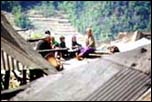 Nagaland also has a high rate of literacy -- 66 per cent of
the population is literate. And like other remote places there are no jobs other than in the government and schools. Development is zilch, and the hand of corruption, it is said, strangles basic services. For many militant
organisations offer a job to do. Nagaland also has a high rate of literacy -- 66 per cent of
the population is literate. And like other remote places there are no jobs other than in the government and schools. Development is zilch, and the hand of corruption, it is said, strangles basic services. For many militant
organisations offer a job to do.
Ironically, Nagaland is a
dry state, but even the chief minister serves Scotch to
his guests.
The Naga's favourite drink -- you can call it their national drink, but that would be treason -- is rice beer or zutho. Made out of rice through
an elaborate fermentation process, it is available in various levels
of potency. 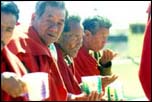 Zutho is guzzled like sherbet here and guests are traditionally welcomed with large plastic bathroom-type mugs of the brew. Nagas
are introduced to the drink at an early age. Children graduate from the less potent fermentation to concoctions with more punch as they attain adulthood. Zutho is guzzled like sherbet here and guests are traditionally welcomed with large plastic bathroom-type mugs of the brew. Nagas
are introduced to the drink at an early age. Children graduate from the less potent fermentation to concoctions with more punch as they attain adulthood.
In villages, roasted millet or a mash of soya seeds and
red chillies is usually served along with a mug of zutho. It is advisable to go slow on the soya mash which has a deceptively delicious appearance; the red chillies render the dish explosive.
Soya to the Nagas is what the coconut is to the Malayalees. Sprinklings of soya can be found in many dishes; the taste of soya may put you off though. Pork is the staple diet while beef, mutton, dogs, deer, porcupine, chicken, snails, grubs and rat supplement it. And fish, prawns, eels, frogs, crabs, clams and lobsters make interesting entrees.
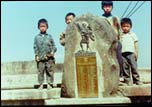 In Kohima, the places of interest can be counted on the fingers of one's hand. A war cemetery, a museum and the Catholic cathedral at Aradura hill which can be seen from Hotel Japfu. The war cemetery -- which keeps alive the memories of officers and soldiers who died fighting in the Battle of Kohima to halt the Japanese invasion of British India in April 1944 -- is situated at a location that provides a a wonderful view of Kohima. In Kohima, the places of interest can be counted on the fingers of one's hand. A war cemetery, a museum and the Catholic cathedral at Aradura hill which can be seen from Hotel Japfu. The war cemetery -- which keeps alive the memories of officers and soldiers who died fighting in the Battle of Kohima to halt the Japanese invasion of British India in April 1944 -- is situated at a location that provides a a wonderful view of Kohima.
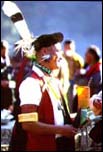 The museum would be the correct place to begin one's tour of Kohima. Though it is small, it gives a fair idea of Naga tribes and traditions, of which little is known to most Indians. There is an interesting display of Naga jewellery, as well as a large collection of stuffed animals, that represent the wildlife of the state. The museum would be the correct place to begin one's tour of Kohima. Though it is small, it gives a fair idea of Naga tribes and traditions, of which little is known to most Indians. There is an interesting display of Naga jewellery, as well as a large collection of stuffed animals, that represent the wildlife of the state.
After you finish with the three sights of Kohima town, it is time to head for
the countryside. Twenty kilometres west of Kohima lies the historic Khonoma village. Khonoma is
an Angami village and the Angamis are the dominant tribe of Kohima district. The Kukis, Rengmas and Zeliangs are the other tribes native to this district. Khonoma was the site of two famous Naga rebellions -- one against the British in 1879, the other against the Indian army in 1956.
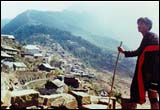 The village breathes history and Khonoma is the native village of Zapu Phizo -- the Gandhi and Mao of the Nagas -- who led the first round of the ongoing movement to free Nagaland. The village breathes history and Khonoma is the native village of Zapu Phizo -- the Gandhi and Mao of the Nagas -- who led the first round of the ongoing movement to free Nagaland.
Thirty kilometres south of Kohima is located Dzukou Valley. Beautiful, lush-green and picturesque, it is Nagaland's Valley of Flowers. A carpet of bamboo brush gives the valley the look of a well-mowed English lawn. In summer, wild herbs, white and yellow lilies and hundreds of other species of flowers play riot across this carpet and a confusion of colours appear on the hillsides as hundreds of rhododendrons -- some of them belonging to the larges species of the flower in the world -- take bloom. Dzukou (it is pronounced with the ‘d’ silent) is touted as one of the best trekking spots in the North-East.
From Kohima I head for Mokokchung, the heart of Nagaland and the terrritory of the Ao people. Buses to and from one district to another in Nagaland leave only twice in a day. The first bus leaves early in the morning -- usually 5 am -- and reaches its final destination before dark. The other bus leaves just before dark -- 4 pm -- and reaches its destination early in the morning. Nagaland is a `disturbed area' and life comes to a standstill very early in the evening, hence the bus services have been adjusted such that people get to their destinations before dark or before the day begins.
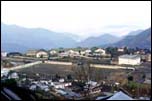 At night the buses huddle together and move in convoys. This gives them a
feeling of security and prevents undue harassment from security forces. Even then, one has to be prepared for multiple security checks and the awkward questions that come your way.
Mokokchung, at 3,975 ft, is lower than Kohima, but equally cool. It is also prettier and not as cluttered with construction as Kohima. The Tourist Lodge and Circuit House offer a good choice of rooms. There are a few private lodges offering fairly decent bed and boarding. Mokokchung, however, does not offer many places of interest that one can visit. One can spend time ambling about the town, gorging on pork chow, dunking coffee and putting one’s feet up and taking it easy. The cool air, soothing ambience, magnificent view and hospitable people make you want to extend your stay here.
There are seven districts in Nagaland, equally enchanting and home to different tribes. Since moving around is not easy it takes a good measure of time to cover all of them. Moreover, tourism is not an organised business here. In fact, Nagaland, caught up in a crisis of identity, hardly seems ready for the tourist.
But, despite the hassles, visiting Nagaland is a bewitching experience. A place from where even as you depart your mind is turning over plans for the next visit.
Fast Facts
The political situation in Nagaland:
Despite the fact that a faction of the Zapu Phizo-founded Nagaland National Council broke away to form the United Democratic Front and signed the Shillong Accord in 1974, the movement for an independent Nagaland is very much alive in the state.
In 1980, a division of the NNC, headed by Thengaling Muivah, severed ties with the main party to form the National Socialist Council of Nagaland. This political group is responsible for the current insurgency in Nagaland. The situation is all the more sensitive because Nagaland shares a border with Myanamar. In the past, Chinese troops have also indirectly intervened on behalf of the Naga rebels to help their cause.
Permissions required for entry into Nagaland:
Visitors to Nagaland are not encouraged by the government especially when it is purely for the purpose of tourism.
For Indian passport holders who arrive at Dimapur, the first thing to do would be to get the `Inner Line Permits' from the additional deputy commissioner's office. An ILP is a must if one proposes to travel around in Nagaland. Advice on travelling to the state and the permits can also be obtained at Nagaland House in Delhi (29, Aurangzeb Road, New Delhi, tel # 011-3015638) and Calcutta (13, Shakespeare Sarani, Calcutta, tel # 033-225247).
Foreigners require 'Restricted Area Permits' from the Foreigners Division, Lok Nayak Bhavan, Ministry of Home Affairs, near Khan Market, New Delhi, before they are allowed into the state. This permission can take a month or more in coming. It is easier to obtain a permit for groups of four or more who intend to visit Nagaland on business rather than for pleasure.
How to get to Nagaland:
The easiest way to get to Nagaland is by an Indian Airlines flight from Calcutta via Jorhat in Assam. Indian Airlines flies to Dimapur four times a week -- Monday, Friday, Wednesday and Sunday. The fare works out to Rs 2,455. Travelling to Nagaland by rail is a complicated, time-consuming and rather challenging journey. The quickest train link would be New Delhi-Guwahati-Lumding-Dimapur or Calcutta-Guwahati-Lumding-Dimapur, involve several changes and take more than two days.
Where to stay in Dimapur:
Hotel accommodation in Dimapur is not a
problem. The government guest house is the cheapest -- Rs 100 per
per day for an ordinary double room. But for the discerning traveller, the town's private hotels offer a range of rooms -- AC, non-AC, with and without a television. Prices range from Rs 200 for a single non-AC room to Rs 500 a day for a double AC-with-television room. And then there are hotels like
Hotel Senti that offer Rs 200 for
an ordinary room to Rs 800 a day for a deluxe room.
Where to stay in Kohima:
Hotel Japfu, PR Hill, tel # 0370-22721. The best hotel in Kohima. The tariff for a single room
is between Rs 300 and Rs 500 per day depending on the occupancy rate, while the tariff for a double room is between Rs 700 and Rs 1,200.
However, cheaper places are available: The Yatri Niwas and the VIP guest house -- for those who can wrangle a deal with government staff -- charge nominal rates. And there is Hotel Pine, Phool Bazaar, tel # 0370-22234, which charges Rs 250 for
a double room. Capital Hotel, where the tariff for a single room is Rs 80 per night, would be the cheapest accommodation available.
Where to stay in Mokokchung: The Tourist Lodge and Circuit House offers a good choice of rooms. Some private lodges also offer fairly decent accommodation.
|

